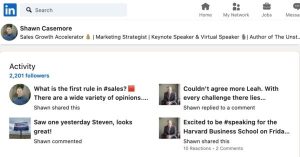You’ve set up your blog, written several posts, and started to gain some followers.
The same three or four people seem to read everything you write and a few even comment or share your posts. It’s a great start, but you’re frustrated because you want more attention for your blog.
This attention – often called reader engagement – is exactly what most bloggers are yearning for.
When readers are engaged with your content, they read it, comment on it, share it, and help spread the word about your blog on the web.
This, in turn, helps you monetize your blog platform and cruise toward a career as a full-time blogger, if that’s what you want.

While it may sound difficult, producing more reader engagement actually comes down to a few simple tactics.
Here’s what you need to know to build more buzz around your blog:
The Rules of Engagement: Giving Readers What They Want
When seeking to increase your blog’s user engagement, it’s important to remember that engagement only comes from giving readers exactly what they want.
This means providing valuable content, a streamlined user experience, easy-to-navigate pages, and plenty of interesting information.
As you make the following changes to your blog, stop and ask yourself “Does this help the reader?” at every step.
Doing this will ensure that you’re making positive changes that will help bolster your engagement numbers.
How to Start a Successful Blog: 5 Tips for Improving Reader Engagement
1. Streamline your content
If you’re a new blogger who is trying to monetize your site, it’s likely that you’ve placed ads in the margins of your page.
While there’s nothing wrong with this, it’s important to keep in mind that you’ll sacrifice user engagement if your ads are too numerous or obtrusive.
In other words, if a reader can’t find your content because there are ads popping up left and right, it’s time to pare it down.
As a general rule, this means avoiding too many ads “above the fold” (of the page), and ensuring that the ads you do have on your site don’t have to reload every time you navigate to the next page or slide.

This will quicken your page’s load times and help you produce a more positive user experience, which makes your readers more willing to share your blog’s content!
For further information on best practices for ad placement, check out this Moz resource.
2. Poll your audience
If you’re a good blogger, you know that successful blogs aren’t really about their authors – they’re about the audience!
Regardless of whether the audience is stay-at-home moms or college students looking for study hacks, it’s important for a blogger to provide truly valuable and relevant content that readers want to engage with.
And what better way to do this than to poll readers?
There are dozens of easy-to-use, free survey tools (like Qeryz, for example) that install directly on your blog.
These tools allow you to ask your readers which topics they most enjoy hearing about, what they’d like more of and what they’d like to see less of.
By polling your readers and taking the answers to heart, you can improve your blog’s traffic and ensure that you’re always providing relevant content people want to share.

If you prefer to poll readers directly through your content, consider including a relevant question at the end of your blog posts, like lifestyle guru Tim Ferriss does on his blog.
Another excellent Polling tool is Polldaddy.

Polldaddy is a WordPress plugin developed by Automattic the group of people behind WordPress so you know it’s a solid plugin and will be kept up to date.
Polldaddy has several plans to choose from including a Free plan which will be perfect for most users.
3. Fill a Niche
As we speak, 27,000,000 pieces of content are being shared around the web on a daily basis.
That’s a whole lot of content and it can make standing out a bit difficult.
Fortunately, there’s a way around drowning in the so-called “Content Sea.”
The answer is to fill a niche. Certain things – like how to start a successful blog, for example – have been written about on the web thousands of times, so how do I make my content stand out?
I write directly to a specific niche of people (beginning bloggers) and offer tools and resources (my WordPress Academy) that similar sites don’t.
To help determine which niche your blog can fill, spend some time evaluating the sites of your competitors.
What can you offer that they don’t? How can you write about similar topics from a unique viewpoint?
For example, can you speak to an audience that your competitors are leaving out?
There are many ways to stand out from the competition and they all start with locating your niche.
4. Include high-quality visuals in your content
Did you know that people remember only 10% of what they hear, compared with 65% of what they see?
Additionally, content that contains images earns 94% more views than text-only content.
Because of this, it’s incredibly important to include relevant, high-quality visuals in your blog content.
These visuals can include infographics (which are shared on social media at a rate that is 3x higher than any other type of content), high-quality stock photos, or even videos.

No matter which format you choose, there’s no denying that visuals are a great way to increase user engagement.
5. Get great at the CTA
The CTA – or call to action – is one of the most important pieces of a great blog.
The reason for this is that a CTA tells readers exactly what you want them to do.
The CTA tells users exactly where, why, and how to click, share, subscribe, or comment and, when done correctly, it can be amazingly effective.
For a great example of a truly click-worthy CTA, consider the CTA on the home page of Evernote’s website.

To ensure that your CTA is a fruitful as possible, be sure that it has each of the following traits:
- It has a button. Including a CTA button, like the one in the Evernote screenshot, makes people want to click. It also simplifies the experience for users.
- It’s compelling. “Remember everything” is compelling. It’s straightforward, actionable, and intriguing and users want what it has to offer.
- It is logical. If you want your CTA to produce more engagement, it shouldn’t be located in the bottom left-hand corner of your page. Instead, it should be in a place where readers can see and interact with it, such as the top of the page or at the immediate bottom of a blog post.
Conclusion
As a new blogger, one of the most exciting pieces of your career is seeing your blog begin to earn more readers and higher levels of engagement.
With these five simple tips, you can streamline this process and earn yourself more high-quality reader engagement than you ever thought possible!
Please share your thoughts in the comments section below and let me know if this article was helpful.
Digital & Social Articles on Business 2 Community(88)
Report Post





